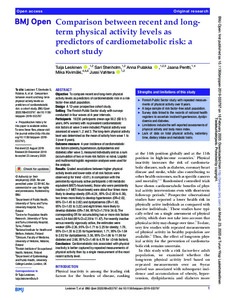Comparison between recent and long-term physical activity levels as predictors of cardiometabolic risk: A cohort study
Sari Stenholm; Jussi Vahtera; Anna Pulakka; Jaana Pentti; Tuija Leskinen; Mika Kivimäki
https://urn.fi/URN:NBN:fi-fe2021042612106
Tiivistelmä
Objective To compare recent and long-term physical activity levels as predictors of cardiometabolic risk in a risk factor-free adult population.
Design A 12-year prospective cohort study.
Setting The Finnish Public Sector study with surveys conducted in four waves at 4-year intervals.
Participants 19 230 participants (mean age 50.2 (SD 9.1) years, 84% women) with no prevalent cardiometabolic risk factors at wave 3 were included. Physical activity was assessed at waves 1, 2 and 3. The long-term physical activity level was determined as the mean of activity from wave 1 to 3 (over 8 years).
Outcome measure 4-year incidence of cardiometabolic risk factors (obesity, hypertension, dyslipidaemia and diabetes) after wave 3, measured individually and as a sum (accumulation of two or more risk factors vs none). Logistic and multinomial logistic regression analyses were used for the analysis.
Results Graded associations between higher physical activity levels and lower odds of all risk factors were observed (p for trend <0.01). In comparison with the persistently vigorously active participants (≥60 metabolic equivalent (MET)-hours/week), those who were persistently inactive (<7 MET-hours/week) were about four times more likely to develop obesity (OR=4.24, 95% CI=2.83 to 6.36), two times more likely to develop hypertension (OR=2.02, 95% CI=1.45 to 2.82) and dyslipidaemia (OR=1.82, 95% CI=1.03 to 3.22) and eight times more likely to develop diabetes (OR=7.84, 95% CI=1.78 to 34.6). The corresponding OR for accumulating two or more risk factors was 5.24-fold (95% CI=2.39 to 11.47). For recently inactive versus recently vigorously active, the estimates were weaker (OR=2.36, 95% CI=1.71 to 3.25 for obesity; 1.78, 95% CI=1.35 to 2.35 for hypertension; 1.71, 95% CI=1.04 to 2.82 for dyslipidaemia; 3.56, 95% CI=1.06 to 11.96 for diabetes and 2.66, 95% CI=1.48 to 4.78 for ≥2 risk factors).
Conclusion Cardiometabolic risk associated with physical inactivity is better captured by repeated measurements of physical activity than by a single measurement of the most recent activity level.
Kokoelmat
- Rinnakkaistallenteet [19207]
